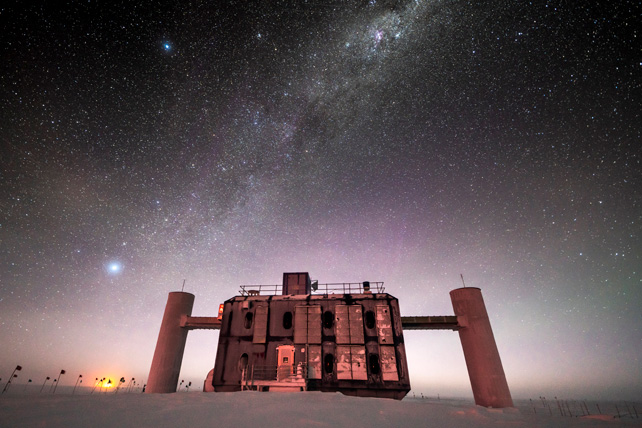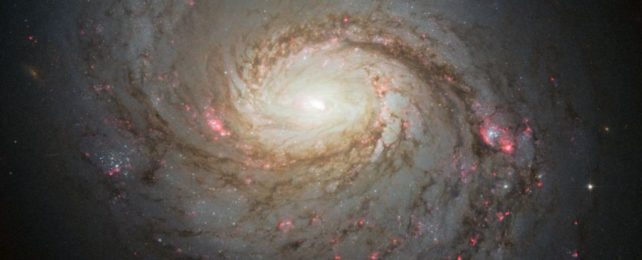The role of active supermassive black holes in the production of high-energy neutrinos from outside the Milky Way seems to have been confirmed. For the second time, physicists have traced these so-called "ghost" particles to the heart of a galaxy across the chasm of intergalactic space.
With this finding, we can start a real census on extragalactic neutrino factories, and use the neutrinos' properties to understand their home environments.
The galaxy in question is a well-studied object known as NGC 1068 – aka Messier 77 or the Squid Galaxy – a beautiful barred spiral located around 47 million light-years away, close enough to see with a pair of binoculars.
And scientists have counted tens of neutrinos in the high-energy teraelectronvolt (TeV) range coming from its direction.
Previously, the only high-energy neutrino was a single TeV particle tracked to an extragalactic source that was traced to a type of galaxy called a blazar named TXS 0506+056, some 3.8 billion light-years away.
This makes the new collection of data, obtained over a 10-year period by the IceCube Neutrino Observatory, an absolute treasure trove.
"One neutrino can single out a source. But only an observation with multiple neutrinos will reveal the obscured core of the most energetic cosmic objects," says physicist Francis Halzen of the University of Wisconsin-Madison and principal investigator of IceCube.
"IceCube has accumulated some 80 neutrinos of teraelectronvolt energy from NGC 1068, which are not yet enough to answer all our questions, but they definitely are the next big step towards the realization of neutrino astronomy."

Neutrinos are almost massless subatomic particles produced by radioactive decay that permeate the Universe.
They're streaming, constantly, through everything, among the most abundant particles in the Universe. They're streaming through you, right now. And this is what makes them tricky to detect: They barely interact with anything.
To a neutrino, normal matter in the Universe may as well be smoke and shadows. This is why we call them ghost particles.
It's this very property, though, that makes them so potentially useful to study. Because they're unaffected by the Universe, they always travel in a straight line.
And high-energy neutrinos are produced exclusively in processes that involve the acceleration of cosmic rays, such as the powerful jets generated in the extreme environment around an active supermassive black hole.
If we want to learn about these neutrino factories, though, we need to find the neutrinos, and this is where IceCube comes in. Buried in the freezing dark beneath the dark Antarctic ice, photodetectors look for the showers of light produced when neutrinos do occasionally interact with atoms or molecules.

And this is how a tight, international collaboration, carefully analyzing 10 years' worth of data collected by the observatory, was able to identify 80 high-energy neutrinos in the 1.5 to 15 TeV range that tracked a straight line back to NGC 1068.
NGC 1068, as we have already noted, is an active galaxy. It's a barred spiral, like the Milky Way; unlike the Milky Way, the supermassive black hole at the heart of NGC 1068 is devouring matter at a furious rate from the space around it.
The black hole is ringed around the equator by a vast torus and disk of dust and gas. This orbits and feeds into the black hole; the gravity and friction in the torus and disk produce insane amounts of heat and light.
Not all the material ends up beyond the event horizon of the black hole. Some of it, scientists think, gets accelerated along the black hole's magnetic field lines to the poles, where it is launched into space in the form of powerful jets of plasma that punch through space almost at light speed.
If the jet is pointed in our direction, we call that galaxy a blazar; TXS 0506+056 is a blazar, and analysis suggests its 300 TeV neutrino was produced in the Earth-pointing jet.
The jet of NGC 1068 is not pointed in our direction. In fact, the galaxy is oriented in such a way that much of the high-energy light from the active galactic nucleus is obscured by dense dust. That means the neutrinos could be a way to probe a black hole difficult to otherwise study.
"Recent models of the black hole environments in these objects suggest that gas, dust, and radiation should block the gamma rays that would otherwise accompany the neutrinos," says physicist Hans Niederhausen of Michigan State University.
"This neutrino detection from the core of NGC 1068 will improve our understanding of the environments around supermassive black holes."
The team interprets the neutrinos as a signature of particle acceleration and says that the discovery suggests that active galactic nuclei make a significant contribution to the neutrino population filling space.
They also say that the discovery is a breakthrough for neutrino astronomy and that NGC 1068 may, in the future, become one of the cornerstones of the field.
"Several years ago, NSF initiated an ambitious project to expand our understanding of the Universe by combining established capabilities in optical and radio astronomy with new abilities to detect and measure phenomena like neutrinos and gravitational waves," says physicist Denise Caldwell of the National Science Foundation, which funded IceCube.
"The IceCube Neutrino Observatory's identification of a neighboring galaxy as a cosmic source of neutrinos is just the beginning of this new and exciting field that promises insights into the undiscovered power of massive black holes and other fundamental properties of the universe."
The research has been published in Science.
